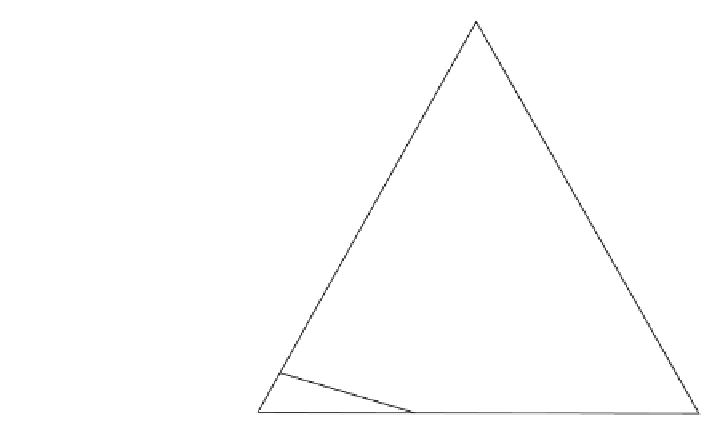Geology Reference
In-Depth Information
Fig. 7.6 The phase triangle
showing that there is a
maximum on the
eld
boundary between nepheline
and feldspar. A few
conjugation lines in the
K-feldspar and kalsilite field
in the system P(H
2
O) = 0.5
GPa are also projected on to
the anhydrous base (after
Zhang and Mackenzie 1984)
Qz
Ab
Or
L
Lc
M
V
VV
V
VVVVV
Ne
Ks
7.2 Phase Relations in the System Nepheline
Kalsilite
SiO
2
-
-
at 2 Gpa [
P
(H
2
O) =
P
(Total)]
Gupta et al. (2010) studied the system nepheline
SiO
2
at P (H
2
O) = 2GPa
and various temperatures (Fig.
7.7
). It may be noted that with the increase of
pressure to 2GPa, the
kalsilite
-
-
field of leucite
ss
is completely eliminated, and there is an
additional
field of jadeite
ss
, as suggested by Huang and Wyllie (1975).
The study of Gupta et al. (2010) demonstrates that there are two eutectics:
(1) E
1
occurs at Kls
18
Ne
52
Qtz
30
and 620
C, where jadeite
ss
, sanidine
ss
,
nepheline
ss
liquid and vapour are in equilibrium, and (2) E
2
occurs at Kls
49
Ne
25
Qtz
26
and 615
±
10
°
±
10
°
C, where nepheline
ss
, kalsilite
ss
and sanidine
ss
coexist with liquid and
vapour.
They established three-phase triangles (Fig.
7.8
) to mark the courses of the
compositions of the liquids in equilibrium with crystalline phases. For example, a
liquid of composition 1 (lying on the cotectic) is in equilibrium with nepheline of
composition 3; likewise, a liquid of composition 10a is in equilibrium with feldspar
of composition 10b (Fig.
7.8
). A temperature maximum (M) occurs at
Kls
35
Ne
38
Qtz
27
and 635
C (Fig.
7.8
). From the maximum, the cotectic moves
toward E
1
or E
2
as established by the three-phase triangles (points 4
°
-
5
-
6 and points
7
9). Similarly, a melt (11) coexists with feldspar (13) and feldspathoid (12).
Furthermore, feldspathoid (12) does not fall on the nepheline
-
8
-
kalsilite join because
kalsilite incorporates both nepheline and excess silica in solid solution. The location
of the three-phase triangles was established by electron
-
microprobe data. The
maximum is related to the intersection of the nepheline
-
K-feldspar join with the
-
nepheline + feldspar cotectic phase boundary.































































Search WWH ::

Custom Search